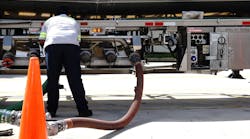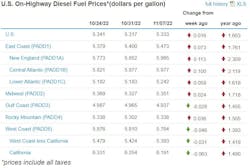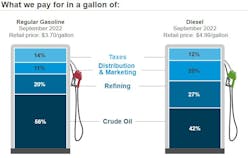The U.S. average price for diesel fuel still can’t decide what it wants to do, but the market may decide soon enough. Supply concerns heading into the holidays and winter are starting to creep into the conversation about fuel, meaning prices might be headed north more than this week's slight increase.
Even the U.S. government’s own Energy Information Administration (EIA) is pinning diesel prices that are well above $5 now—up slightly this week, 1.6 cents to $5.333 a gallon—on low inventories headed into winter compared to demand that is high and bound to climb higher unless a recession cools activity.
See also: U.S. diesel average trickles down 2.4 cents
Yahoo Finance analyst Ines Ferré also blames seasonal factors for persistently high diesel these days.
Another source says supplies of distillates—diesel is one, along with jet fuel and heating oil—have fallen to their lowest levels since 2008. Ferré joined a chorus this week in saying a blend of decreased total refining capacity, seasonal maintenance at the U.S. refineries that still are operating, and the cutoff of imports from Russia after that country's forces invaded neighboring Ukraine this spring (the U.S. was importing 700,000 barrels of Russian oil per day prior to the invasion) mean prices aren’t heading in the direction that freight haulers want them to: down.
Gasoline also edged higher for the week of Nov. 7—up 5.4 cents to $3.796—making gas almost $1.54 per gallon cheaper than diesel. Diesel is traditionally more expensive than gasoline, but the same sources (EIA, OilPrice.com, and AAA) that are ringing alarm bells about diesel shortages say reduced distillate supplies are not helping matters in narrowing the gap between diesel and gas, either.
Demand for gasoline also is lower than demand for diesel, which could account for the lower price pressure on gas, according to another report from AAA, which also cites lower oil prices than the $115- to $120-per-barrel levels that marked the surge in prices for all fuels after the Russian invasion this spring.
U.S. crude inventories also were down 3.1 million barrels the week ended Oct. 28, according to FleetOwner sister publication Oil & Gas Journal, which cited EIA data. The Biden administration has been adding crude from the U.S. Strategic Petroleum Reserve for the better part of 2022 to help restrain soaring fuel prices, which along with truck parking, topped all industry concerns in the American Research Transportation Institute's annual survey, which was released on Oct. 22.
Regionally, diesel was up for the week of Nov. 7 in every region of the U.S. except two of them, the Gulf Coast (where it was down 2.8 cents to $4.937 per gallon) and the traditionally priciest West Coast (4.6 cents lower to $5.764). Trucking’s main fuel shot the highest on the East Coast, where it rose 7.3 cents to $5.473. Diesel was up 3.6 cents in the Rocky Mountain region to $5.338 and rose 2.4 cents to $5.351 in the Midwest.
East Coast diesel prices are soaring relative to the rest of the U.S. because inventories in the region are almost half what they normally would be this time of year.






